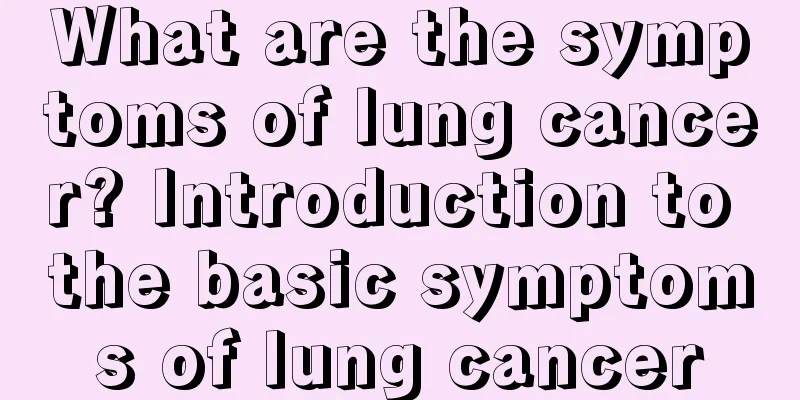What are the symptoms of lung cancer? Introduction to the basic symptoms of lung cancer

|
The first symptoms caused by the primary tumor accounted for 27%. The symptoms were related to the location of the primary tumor. Central lung cancer was manifested by irritating dry cough, breathlessness, repeated pneumonia in the same location, hemoptysis or asthma, recurrent laryngeal nerve, phrenic nerve compression symptoms or superior vena cava compression syndrome. Peripheral tumors are more common with symptoms such as chest pain, breathlessness or pleural effusion. Large peripheral lesions, central necrosis, and cavities eventually present similar manifestations to lung abscesses. Common symptoms of primary lung cancer are grouped. Sometimes lung cancer needs to be treated surgically, but sometimes patients will also use palliative methods to treat the disease. Lung cancer examinations should be done before and after surgical treatment to achieve the purpose and effect of treating the disease. There are usually no symptoms in the early stages. Almost two-thirds of lung cancer patients are already in the advanced stage (stage III or IV) when they seek medical treatment. 95% of patients have clinical examination results. Primary tumors, metastatic tumors, systemic symptoms or tumor-associated symptoms can all be the patient's first symptoms. The first symptom caused by the primary tumor accounts for 27%. The symptoms are related to the location of the primary tumor. Central lung cancer is manifested by irritating dry cough, breathlessness, repeated pneumonia in the same location, hemoptysis or asthma, recurrent laryngeal nerve, phrenic nerve compression symptoms or superior vena cava compression syndrome. Peripheral tumors are more common in symptoms such as chest pain, breathlessness or pleural effusion. Large peripheral lesions, central necrosis, and cavities eventually present similar manifestations to lung abscesses. Distant metastatic lesions cause the first symptoms in 32% of cases. Common distant metastatic sites include: lymph nodes, adrenal glands, liver, bones, lungs, brain and chest wall, which produce some corresponding symptoms, indicating that lung cancer has reached the late stage, such as: tumors near the mediastinum can invade the phrenic nerve, causing ipsilateral diaphragm paralysis, and under fluoroscopy, the diaphragm position is elevated and abnormal respiratory movements are shown; invade the ipsilateral recurrent laryngeal nerve, causing hoarseness, ipsilateral vocal cord paralysis and fixation in the median position; compress the superior vena cava, causing edema of the head, face and upper limbs, and venous distension; invade the pleura, causing a large amount of blood in the pleural cavity. Fluid accumulation, aggravating shortness of breath symptoms, or directly invading the chest wall, causing severe chest pain; lung cancer at the tip of the upper lobe is located at the entrance of the thorax, also known as superior pulmonary sulcus cancer, which can invade and compress the brachial plexus, cervical sympathetic ganglia, and subclavian arteries and veins, producing a series of special symptoms, such as numbness and pain in the upper limb on the same side, which gradually intensifies and becomes difficult to tolerate; atrophic changes in muscles and skin, engorgement and edema of the upper limb veins; and cervical sympathetic syndrome such as ptosis of the upper eyelid on the same side, miosis of the pupil, enophthalmos, and anhidrosis on the face. . In fact, there is a lot of knowledge about lung cancer, such as some knowledge about chemotherapy, but we often also need to provide psychological care when understanding lung cancer. This is because patients with lung cancer will also suffer a lot of pain. Only by dealing with the patients' pain well can we achieve the effect of treating the disease. |
Recommend
What are the symptoms of recurrence after laryngeal cancer surgery
Every disease will have its symptoms, but if we d...
How to effectively remove acne
It is really painful to have pimples on your face...
13 ways to eat Yuanxiao, the most healthy way. The meaning of Yuanxiao
Yuanxiao means reunion. Some people like to eat i...
It's uncomfortable to breathe in cold air through the nose
The nose is like a filter for the human body, whi...
Bile reflux causes chest pain when swallowing food
For some patients with stomach problems, they oft...
There are white lumps inside the hairtail
The white lumps in hairtail are mainly caused by ...
Should I use white vinegar or rice vinegar to wash my face?
When washing their faces, women pay much attentio...
4mm kidney stone
Kidney stones often do not have obvious symptoms ...
What are the symptoms of urethral caruncle?
Patients need to pay attention to the symptoms of...
Can I eat a slightly rotten mango?
Mango is a food that tastes good and is very nutr...
Is sugarcane an allergy-inducing food?
Irritating foods are foods that have the effect o...
Where is liver cancer most likely to metastasize? How to prevent metastatic liver cancer?
Liver cancer is very common among the population....
Wrist joint rehabilitation training
The wrist joint is the most important part of the...
The strongest aphrodisiac wine recipe
In fact, using a combination of medicinal materia...
What to do if you have central nervous system disorder
Central nervous system disorders have a huge impa...









